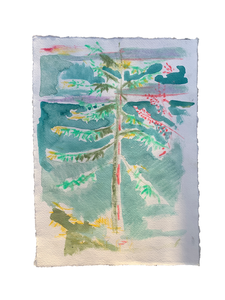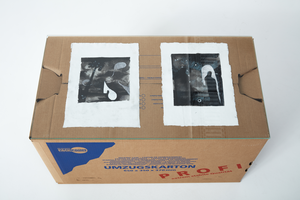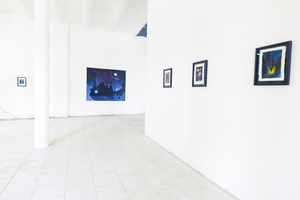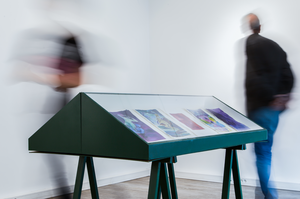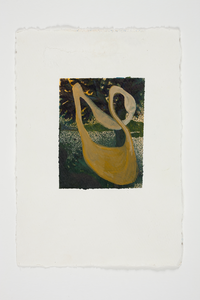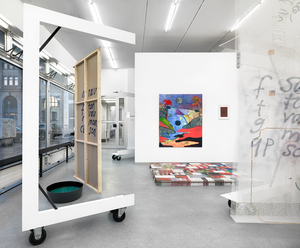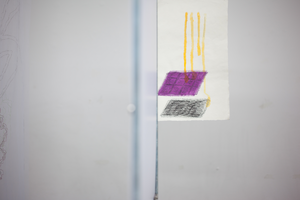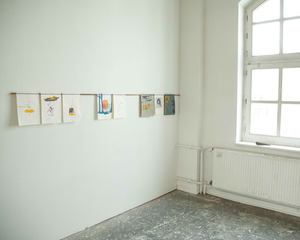Works: more
After Silence, after nature, colours, light or intimacy. Mostly it is things or states that are invisible.
So the aim of my work is to make the invisible visible.
In order to do so, I have to partially detach myself from the visible.
So if one of the goal is detachment, one can assume that an artist has everything at his disposal that constitutes the world in order to bring about this abstraction. Even recognizable forms.
Sometimes I even enjoy telling a story.
Anyway, as soon as two things are connected, be it color, a place, forms, figures or trees, a story is told.
So in the end I'm going to tell stories, let figures collide with each other and everything begins to be allowed, like a theater play only the origin of these stories is not fiction, but pure seriousness.
Dance encounters sculpture, sculpture encounters sound and sound encounters painting.
The audio installation generates an imaginary field, which creates a soundscape, where the movements of the single sound elements and the movements of the observer, dancer or visitor are building an unhierarchic nonideological system or home.
Choreographer and Contemporary Dancer Outi Elena Valanto, Sound Artist Sascha Kregel and Painter and Sculptor Christopher Gerberding explore the physical and subjective state of belonging in space, in a landscape or in a society, familiar structure. It observes how the emotions, memories, and senses affect the perception of home.
„When light enters a space, space begins to exist, from an unknown to a known state of being. What if feelings and body are the real origins of the human being? Is the time the matter that revolutionizes the incognito space to be something familiar, a habitat?“
Outi Elena Valanto
This piece offers perspective where movement and sensitivity can embody the origin land. Perhaps belonging is longing something non-material to a non-territory. A state that is a product of imagination. With dance, soundscape, painting, and installation this piece examines the eternal inquiries of humanity and provides a platform for the audience to individual reflection.
Meinem verehrungswürdigen Jakob Burckhardt.
Das war der kleine Scherz, dessentwegen ich mir die Langeweile, eine Welt geschaffen zu haben, nachsehe.
Nun sind Sie - bist Du - unser grosser grösster Lehrer: denn ich, zusammen mit Ariadne, habe nur das goldne Gleichgewicht aller Dinge zu sein, wir haben in jedem Stücke Solche, die über uns sind...
Dionysos
[...Nietzsche]
Will a new form of collectivity follow the age of hyperindividuality? What sways common experience? And what does the withdrawal of the individual mean for art?
The Frances Scholz class of Braunschweig’s University of Fine Arts conceived this group exhibition not as a display of genius and autonomous works, but rather as an examination of the relationship between collaboration and individual artistic stances.
The exhibition was preceded by a zine workshop with the American artists V. Vale and Marian Wallace where the class explored concepts of artistic self restriction and rejections of consumerism and notions of success. As a form of consensus, the “no” in the exhibition title references mechanisms within the art world as well as university obligations. It also describes an artistic approach: can a withdrawal, even from the image itself, be seen as a form of protest?
Like the class’ installation Kennen Sie Turner? which was shown this April at the New York project space Shoot the Lobster, the current exhibition was a collective effort and conceived site-specifically. The contradictions and disruptions, but also the unity and the strength that came out of their collaborative creative process are on show here. The resulting works reject the idea of single authorship and form a playful yet precise whole that does not allow for any additions or changes.
What is clearly transmitted by the work of the Scholz class is the insight that processes of change can only be conceived together, but it also conveys a sense of unease owing to the absence of utopias – both social and economical.
Text by Diana Weis / 2017
Translated by Katja Taylor
